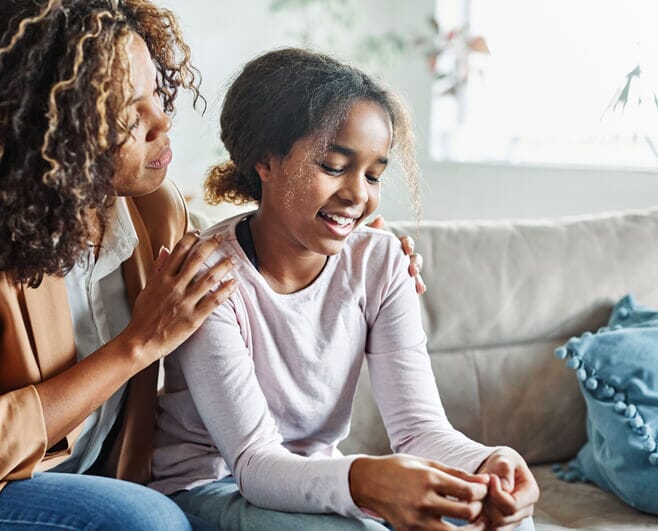Understanding the Stages of Puberty for Girls

Puberty can be both exciting and confusing, and knowing what to expect makes a big difference. That's why it's important to start conversations early about the changes girls will experience, helping them feel prepared and confident.
Our guide is here to guide you through the stages of puberty in girls, offering insights into the physical, emotional, and hormonal changes that occur.
5 Stages of Puberty in Girls
As your daughter grows, she'll go through five stages of puberty, each bringing its own changes. So, let’s take a look at each stage of puberty in girls to help you know what to expect and when.
|
Stage |
Age Range |
Changes and Conditions |
|
Stage 1: Early Signs |
8+ |
At this early stage, there aren't any visible changes. However, hormones will start to send signals to various parts of her body, laying the groundwork for the transformations to come. |
|
Stage 2: Onset of Physical Changes |
9-11 |
During this stage, the first signs will become visible. Your girl might notice small, firm lumps under her nipples and begin to have breast bud pain. This is usually the first indication that the changes have started. Additionally, around this time, she may also begin to grow some pubic hair. |
|
Stage 3: Visible Physical Development |
12+ |
In this stage, you'll notice more changes. Breasts will continue to grow and take shape, and both pubic and underarm hair will become more noticeable. Your daughter might also have a significant growth spurt, shooting up in height. Her skin may get oilier, and she might start to experience acne. |
|
Stage 4: Maturation Continues |
13+ |
Menstruation often begins during this stage, which is a big milestone. It's a good time to talk to your daughter about what to expect with her period and how to manage it. Additionally, her breasts will continue to fill out, and pubic hair will become thicker. However, the rate of height growth slows down a bit compared to the previous stage. |
|
Stage 5: Full Physical Maturation |
15+ |
By this stage, your daughter will have reached full physical maturity. Her breasts and reproductive organs will be fully developed, and her menstrual cycles will become more regular. This marks the end of the major physical changes for girls. She might also notice her body shape becoming more defined, with a bit more fat distribution around the hips and thighs. |
Emotional Changes During Puberty

Alongside physical changes, girls may experience emotional fluctuations. Some common emotional changes your girl might experience are:
-
Mood Swings: Sudden shifts in mood, from happiness to sadness or irritability, can occur frequently.
-
Increased Sensitivity: She might feel more sensitive or easily hurt by comments or situations that wouldn’t have bothered her before.
-
Self-Consciousness: Growing awareness of her changing body can make her feel more self-conscious and worried about her appearance.
-
Anxiety and Worry: Concerns about fitting in, friendships, and school performance might become more pronounced.
- Emotional Outbursts: She might have intense reactions to seemingly small issues, leading to tears or anger.
Understanding these changes and maintaining open communication can help her feel more comfortable and supported during this time.
Here are some tips for how to explain puberty to a girl:
|
Strategy |
Description |
|
Communication |
Let her know it’s okay to express her emotions and reassure her that you’re there to listen without judging. |
|
Positive Reinforcement |
Praise and support her positive behavior and emotional management. Recognize her efforts to handle her emotions maturely and remind her that seeking help when needed is perfectly okay. |
|
Creative Outlets |
Encourage her to engage in creative activities like drawing, painting, or playing a musical instrument. These can be excellent ways to express and manage emotions. |
|
Social Support |
Help her build a support network of friends and family members who can provide emotional support. Encourage her to spend time with positive and understanding people. |
|
Setting Boundaries |
Teach her the importance of setting personal boundaries to protect her emotional well-being. Encourage her to say no when necessary and prioritize self-care. |
|
Time Management |
Assist her in developing time management skills to reduce stress. Help her plan and organize her tasks to prevent feeling overwhelmed. |
|
Mindfulness Practices |
Introduce her to mindfulness practices such as mindfulness meditation or mindful eating. These can help her stay present and reduce anxiety about future events. |
Additional Puberty Changes

Alongside the main stages of puberty, there are other developments your daughter will experience.
Keep a look-out for these signs so you can help her manage them:
- Sweating and Body Odor: During this period, she is likely to notice an increase in sweating and body odor. This is completely normal. Encourage her to take daily showers and consider using deodorant to help manage any odor. It’s also a good idea to wear clean clothes and practice good hygiene habits.
- Acne Management: Hormonal changes can sometimes lead to oily skin and acne. To address this, establishing a regular skincare routine can help keep your skin clean and reduce breakouts. This may involve washing your face twice a day with a gentle cleanser. Additionally, over-the-counter acne treatments can also be helpful. However, if acne becomes severe, it may be necessary to consult with a dermatologist for additional treatment options.
- Hair Growth: It’s likely she will notice hair growing in new places, such as under her arms and in her pubic area. Initially, this hair will be soft and light but will become darker and coarser over time. You can talk to her about options for hair removal if she is interested, but also reassure her that it’s perfectly normal and natural.
- Breast Asymmetry: It’s common for one breast to grow faster than the other during development. Reassure your daughter that this is normal and that, over time, they will likely even out. In the meantime, a training bra can help her feel more comfortable and confident.
- Menstrual Cycle: Once menstruation starts, it might take a while for her periods to become regular, as they can be irregular in the beginning, with varying flow and cycle lengths. Talk to her about what to expect, how to manage her period, and the importance of tracking her cycle.
Tips for Parents
Helping your girl through this transformational time can feel like a big task, but with the right approach, you can make it a lot easier for both of you.
Use Correct Anatomy Terms
It's important to use the correct terms such as "vagina," "breasts," and "menstrual cycle." This can help your daughter feel more at ease discussing her body and make it easier for her to ask questions. Moreover, using the proper terminology will help to normalize these conversations and make her feel more confident.
Be Supportive
Offer plenty of reassurance and be patient as your daughter navigates this phase of her life. Let her know that what she’s going through is completely normal. Encourage her to share her feelings and listen to her without judgment. Your support can make a huge difference in how she handles this transition.
Seek Medical Advice
If something doesn’t seem quite right or if you have any concerns, don’t hesitate to reach out to a pediatrician. It’s always better to get professional advice if you’re unsure about something. Doctors can provide reassurance and help address any issues early on.
Create a Comfortable Environment
Make sure your daughter feels comfortable coming to you with any questions or concerns. Create an open and safe environment for her to express herself. Let her know that no topic is off-limits and that you’re there to support her no matter what.
Educate Yourself
Stay informed about the developments your daughter is going through. The more you know, the better you can support her.
Prepare for Menstruation
Help your daughter get ready for her first period by creating a period kit with pads, panty liners, and a clean pair of underwear. Explain how to use these items and discuss what to expect during her period. This will help her feel more prepared and less anxious when the time comes.
Be Positive
Keep a positive attitude about the ups and downs that this time brings. Celebrate the milestones and reassure your daughter that growing up is a natural and exciting part of life. Your positive outlook will help her feel more confident and less worried about everything she's experiencing.
Bleuet: Supporting Your Daughter Through Puberty

Puberty can be a challenging time, but at Bleuet, we’re here to make the journey smoother and more comfortable for your daughter. Specializing in bras and underwear designed specifically for teens, we offer practical and stylish solutions during this important phase.
Here’s what sets us apart:
- Teen-Focused Design: Our bras and underwear are made to fit growing bodies comfortably. They’re ultra-soft, reversible, and seamless, perfect for teens just starting their journey.
- Comfort and Support: We use lightweight, breathable fabrics to ensure all-day comfort. Our tag-free design and minimal seams are ideal for girls with sensory sensitivities, helping to ease any discomfort.
- Variety of Styles: From first bras to sports bras and supportive options, we offer styles to suit every need. Our underwear is designed to complement our bras, providing a complete set for growing teens.
- Inclusive Sizing: With a wide range of sizes, we ensure a perfect fit as your daughter grows and her body changes.
- Fun Unboxing Experience: We make the experience exciting with our special unboxing. Each first bra and underwear shipment comes beautifully packaged with surprises, making your daughter feel special and celebrated during this important milestone.
Choose Bleuet and provide your daughter with high-quality, comfortable products that will support her every step of the way.
Final Thoughts – How to Talk to My Daughter About Puberty
Talking to your daughter about puberty is so important for her confidence and comfort. Start conversations about the stages of puberty girls early, use the right words for body parts, and always be there with support.
Make sure she knows that everything she's going through is normal and okay. Celebrate the changes as natural parts of growing up. Your support and understanding will help her navigate this journey with confidence and ease.
Remember, being open, honest, and supportive makes all the difference. Together, you can make this time a positive and empowering experience for both of you.
Frequently Asked Questions
What are the 5 stages of girl puberty?
Stages of puberty for girls include early signs with hormonal changes, breast budding and initial pubic hair growth, continued breast and hair development along with growth spurts, the start of menstruation and further maturation, and finally, reaching full physical maturity. Each stage brings different developments in a girl's body.
Do girls finish puberty at 14?
Most girls don't finish puberty at 14. While many shifts, like the start of menstruation, occur around this age, full physical maturity usually continues until around 16-18 years old.
What are the first signs of puberty in a girl?
The first signs of body puberty in girls are usually the development of breast buds, which are small, firm lumps under the nipples. This can start as early as age 8. Pubic hair might also begin to appear around this time.
How long is puberty for a girl?
Puberty for girls typically lasts several years. It usually begins between ages 8 and 13 and continues until around 16-18 years old, although this can vary for each individual.









Leave a comment